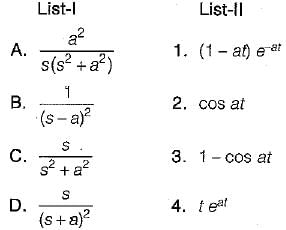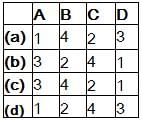Electronics and Communication Engineering (ECE) Exam > Electronics and Communication Engineering (ECE) Tests > Test: Introduction to Control Systems- 2 - Electronics and Communication Engineering (ECE) MCQ
Test: Introduction to Control Systems- 2 - Electronics and Communication Engineering (ECE) MCQ
Test Description
10 Questions MCQ Test - Test: Introduction to Control Systems- 2
Test: Introduction to Control Systems- 2 for Electronics and Communication Engineering (ECE) 2025 is part of Electronics and Communication Engineering (ECE) preparation. The Test: Introduction to Control Systems- 2 questions and answers have been prepared
according to the Electronics and Communication Engineering (ECE) exam syllabus.The Test: Introduction to Control Systems- 2 MCQs are made for Electronics and Communication Engineering (ECE) 2025 Exam.
Find important definitions, questions, notes, meanings, examples, exercises, MCQs and online tests for Test: Introduction to Control Systems- 2 below.
Solutions of Test: Introduction to Control Systems- 2 questions in English are available as part of our course for Electronics and Communication Engineering (ECE) & Test: Introduction to Control Systems- 2 solutions in
Hindi for Electronics and Communication Engineering (ECE) course.
Download more important topics, notes, lectures and mock test series for Electronics and Communication Engineering (ECE) Exam by signing up for free. Attempt Test: Introduction to Control Systems- 2 | 10 questions in 30 minutes | Mock test for Electronics and Communication Engineering (ECE) preparation | Free important questions MCQ to study for Electronics and Communication Engineering (ECE) Exam | Download free PDF with solutions
Test: Introduction to Control Systems- 2 - Question 1
Match List- I (Laplace transforms) with List - II (Time functions) and select the correct answer using the codes aiven below the lists:

Codes:


Codes:

Detailed Solution for Test: Introduction to Control Systems- 2 - Question 1
Test: Introduction to Control Systems- 2 - Question 2
A standard signal used for comparison in a closed-loop control system is called the
Detailed Solution for Test: Introduction to Control Systems- 2 - Question 2
Test: Introduction to Control Systems- 2 - Question 3
The difference between the output response and the reference signal is known as the _____ signal.
Detailed Solution for Test: Introduction to Control Systems- 2 - Question 3
Test: Introduction to Control Systems- 2 - Question 4
The Laplace transform of unity function is
Detailed Solution for Test: Introduction to Control Systems- 2 - Question 4
Test: Introduction to Control Systems- 2 - Question 5
The phenomena of ‘limit cycles’ and ‘jump resonance’ are observed in
Detailed Solution for Test: Introduction to Control Systems- 2 - Question 5
Detailed Solution for Test: Introduction to Control Systems- 2 - Question 6
Test: Introduction to Control Systems- 2 - Question 7
A control system is said to be robust when
Detailed Solution for Test: Introduction to Control Systems- 2 - Question 7
Test: Introduction to Control Systems- 2 - Question 8
Which of the following is not correctly matched?
(CLCS = Closed Loop Control System and OLCS = Open Loop Control System)

Detailed Solution for Test: Introduction to Control Systems- 2 - Question 8
Test: Introduction to Control Systems- 2 - Question 9
Which of the following is not true regarding an open loop control system?
Detailed Solution for Test: Introduction to Control Systems- 2 - Question 9
Test: Introduction to Control Systems- 2 - Question 10
As compared to a closed loop system, an open loop system is
Detailed Solution for Test: Introduction to Control Systems- 2 - Question 10
Information about Test: Introduction to Control Systems- 2 Page
In this test you can find the Exam questions for Test: Introduction to Control Systems- 2 solved & explained in the simplest way possible.
Besides giving Questions and answers for Test: Introduction to Control Systems- 2, EduRev gives you an ample number of Online tests for practice
Download as PDF






















